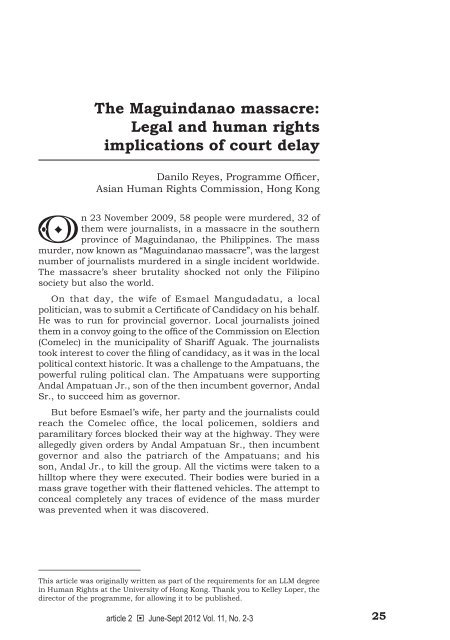You also want an ePaper? Increase the reach of your titles
YUMPU automatically turns print PDFs into web optimized ePapers that Google loves.
The Maguindanao massacre:<br />
Legal and human rights<br />
implications of court delay<br />
Danilo Reyes, Programme Officer,<br />
Asian human Rights Commission, hong Kong<br />
On 23 november 2009, 58 people were murdered, 32 of<br />
them were journalists, in a massacre in the southern<br />
province of maguindanao, the Philippines. The mass<br />
murder, now known as “maguindanao massacre”, was the largest<br />
number of journalists murdered in a single incident worldwide.<br />
The massacre’s sheer brutality shocked not only the Filipino<br />
society but also the world.<br />
On that day, the wife of Esmael mangudadatu, a local<br />
politician, was to submit a Certificate of Candidacy on his behalf.<br />
he was to run for provincial governor. Local journalists joined<br />
them in a convoy going to the office of the Commission on Election<br />
(Comelec) in the municipality of Shariff Aguak. The journalists<br />
took interest to cover the filing of candidacy, as it was in the local<br />
political context historic. It was a challenge to the Ampatuans, the<br />
powerful ruling political clan. The Ampatuans were supporting<br />
Andal Ampatuan Jr., son of the then incumbent governor, Andal<br />
Sr., to succeed him as governor.<br />
But before Esmael’s wife, her party and the journalists could<br />
reach the Comelec office, the local policemen, soldiers and<br />
paramilitary forces blocked their way at the highway. They were<br />
allegedly given orders by Andal Ampatuan Sr., then incumbent<br />
governor and also the patriarch of the Ampatuans; and his<br />
son, Andal Jr., to kill the group. All the victims were taken to a<br />
hilltop where they were executed. Their bodies were buried in a<br />
mass grave together with their flattened vehicles. The attempt to<br />
conceal completely any traces of evidence of the mass murder<br />
was prevented when it was discovered.<br />
This article was originally written as part of the requirements for an LLm degree<br />
in human Rights at the university of hong Kong. Thank you to Kelley Loper, the<br />
director of the programme, for allowing it to be published.<br />
article 2 � June-Sept 2012 Vol. 11, No. 2-3<br />
25


